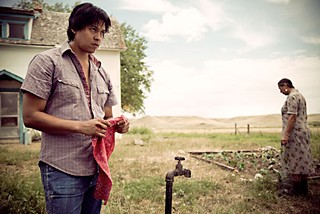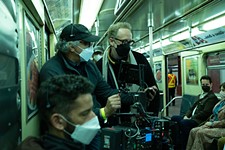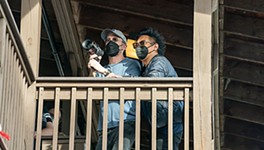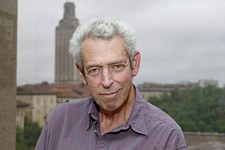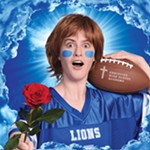Blood Brothers
Bringing James Welch's novel of Native life, 'Winter in the Blood,' to the screen
By Paul Stekler, Fri., Oct. 25, 2013
In 1974, a 34-year-old writer living in Missoula, Mont., published his first novel. James Welch had grown up around the Blackfeet Indian Reservation – up on the Montana Hi-Line, where his father was from – and around his mother's Gros Ventre tribe. As a Native American student studying writing at the University of Montana, he avoided writing about home, thinking it too bleak a topic, until his adviser, the poet Richard Hugo, told him to write what he knew. Write about the reservation, the landscape, the people. Winter in the Blood was the result.
Part tragedy and part comedy, the novel depicted contemporary Native American life in a way that few books, if any, had ever done before. And it immediately was recognized as something special. In a front page New York Times book review, Reynolds Price called it "a nearly flawless novel about human life." Forty years later, the book is cited as a milestone of the Native American literacy renaissance of the Seventies, a book that inspired younger Native writers like Sherman Alexie and Louise Erdrich. And now, because of the efforts of Austin-based director Alex Smith, along with his twin brother and directing partner Andrew, it's a feature film.
Smith, a graduate of UT's Michener Center for Writers, worked in Los Angeles as a screenwriter before moving back to Austin, eventually helping to run the Radio-Television-Film Department's UT Film Institute initiative while teaching writing and filmmaking. He and his brother were no strangers to success in the indie film world. After screening several shorts at the Sundance Film Festival, they returned in 2002 to premiere The Slaughter Rule, starring Ryan Gosling, about six-man football and the disaffected lives of youngsters, white and Native, in a small Montana town.
The Smith twins, Montana natives, grew up as part of a Missoula writers' community that included Welch; Hugo; James Crumley; novelist and essayist William Kittredge; their mother, filmmaker and writer Annick Smith; and the many visitors to their circle, including James Harrison and Richard Ford. Welch was a constant presence in their lives. He met his wife Lois, later the head of the University of Montana's well-regarded writing program, in their living room. Having lost their own father at age 6, the Smiths thought of Welch, in their words, as one of their surrogate dads. But they never thought of filming his book, even after the success of The Slaughter Rule opened up other directing opportunities.
After Welch passed away in 2003, the Smiths filmed a sequence from one of his novels for a memorial and kicked around the idea of making a documentary that would include scenes from all of his books. But then in 2007, Ken White, an actor-writer friend, found a copy of the novel at their mother's house, read it that night, and emailed the Smiths at dawn, asking "Why are you not making this movie?" Six years later, after surmounting the question of how to fund and make a Native American period drama, the three of them have a finished film.
The film features a mostly Native cast including Chaske Spencer and Julia Jones, stars of the Twilight Saga of films, and Gary Farmer, a multiple Independent Spirit Award nominee for his work in Powwow Highway and Dead Man. Alongside are David Morse (The Hurt Locker, Treme, St. Elsewhere), who co-starred in their first feature, and Alex's wife, Dana Wheeler-Nicholson (Fletch, Tombstone, Friday Night Lights). The original score is by the Heartless Bastards, along with songs contributed by Robert Plant, Amy Cook, Courtney Saunders, and other friends of the filmmakers. But the most fascinating part of watching the Smiths' film is sitting for an hour and half and gradually forgetting that you're watching a mostly Native ensemble of actors acting. Interweaving past and present, humor and deep hurt, it's a film that just happens to be about Native lives.
Jim Welch was a friend of mine. I loved Winter in the Blood, and years after reading it, I made a blind call to his home, leaving a message about collaborating on a film telling the story of the Little Bighorn battle – Custer, Crazy Horse, and Sitting Bull – from both Native and white perspectives. And he said yes.
We drove from reservation to reservation, looking for stories and storytellers. Everywhere we went, every Indian person we talked to knew his books, talked about how important his work was to them. One day, we were way out in a little forlorn town on the Northern Cheyenne reservation, Lame Deer, there to recruit tribal historian Bill Tall Bull to be an adviser on the film. And suddenly, staring straight at Jim, Tall Bull began reciting one of Welch's poems. I'll never forget it.
Welch followed his debut novel with a string of gems, including Fools Crow, The Death of Jim Loney, a book of poems called Riding the Earthboy 40, and the nonfiction Killing Custer, which I helped him to write. Even after his many book awards, a decade after his death, Welch's work is relatively unknown outside of Native and Western circles. The Smiths hope their film will help bring more focus to someone who was known as a writer's writer to his many better-known friends.
"The book is so much about how you stay connected to those you lose without getting trapped in the trauma of loss," Alex Smith says. "You use those you lost to make your own life more valid. You use their life force to help you move on. There are ghosts here every day. It's a beautiful book, and we hope that we did it the justice it deserves."
Winter in the Blood screens Sunday, Oct. 27, 5pm, at the Paramount Theatre.





